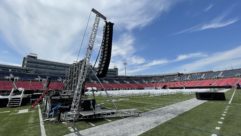Highland Park United Methodist Church
Jul 1, 2001 12:00 PM,
By Alex Artaud
WITH ITS GOTHIC ARCHITECTURE, ORNATELY DESIGNED vaulted beams and tiled marble floor, the main sanctuary of the Highland Park United Methodist Church in Dallas, Texas, is a lovely, spacious 1200-seat facility. Designed and built in 1916 and located near Southern Methodist University, the church has 13,000 members, 7000 of whom are active, making it one of the largest United Methodist church communities in the United States. It’s also quite busy, with nine services offered weekly in the sanctuary, as well as services in the smaller chapel and the Great Hall.
Faced with increasing complaints from parishioners about the lack of sound clarity during services in the main sanctuary, the church contacted Rick Robinson, president of Sound Reinforcements in Burleston, Texas. A 16-year old company with valuable experience working with the acoustical idiosyncrasies found in houses of worship, Sound Reinforcements was asked to optimize the sound distribution without compromising the integrity of the church’s structure and design. “The church had complaints of lack of intelligibility and uneven coverage.” explains Robinson. “Especially noticeable were some holes in the back two-thirds of the seating sections in the extreme left and extreme right areas due to poor loudspeaker positioning. They also couldn’t get enough gain before feedback from the pulpit and the choir loft. When they contracted us in August of 2000, we did a preliminary acoustical study and modeled the entire sanctuary in EASE software. Then, we consulted with Topper Sowden, of Sowden Associates, who reviewed the design before we presented it to the client.”
Gary Smith, who represented the church, liked Robinson’s proposal and contracted Sound Reinforcements. From the beginning, it was a relationship based on trust. Adds Robinson, “Gary basically said, ‘Whatever you think is best for the church, do it.’” So with church volunteer and engineer Jack Harkey supervising the installation, Robinson got to work with his associate, systems designer Gary Stout.
CLARITY IN THE TRANSEPT AREA
The church had been using a system that featured Frazier CAT56 speakers paired with dual, 12-inch, low-frequency Electro-Voice drivers at each cluster location. Three were located directly over the altar, one over the center area, and another one directly above the balcony.
“The loudspeaker clusters above the altar are 52 feet in the air and didn’t adequately cover the area.” says Robinson. “The challenge was to keep the sound from bouncing off the walls, back to the altar, then on to the choir. We knew that to correct the gain-before-feedback problem, we had to avoid exciting the transept areas. The only way we could effectively do this was to put the sound closer to the listener.”
The novel solution Robinson arrived at was an under-pew sound-delivery system. “Originally, I had started to design a wooden loudspeaker enclosure that would fit underneath the pew. All anyone would have seen was the front of the loudspeaker. I was going to use dual 4-inch coaxial loudspeakers and use the section underneath the pew as a backbox. In other words, I would have had to create another box that mounted to the bottom of the pew. That would have been very labor intensive and expensive.”
While looking for another workable solution, Robinson received some literature on the TOA H-1 interior-design loudspeaker, part of TOA’s H-series line of compact loudspeakers (see Sidebar, “Spotlight on the TOA H-1”). Robinson reviewed the specifications and thought the H-1s would provide the required frequency dispersion for the project. He took an H-1 sample to the job site to see if the rotation angle would suffice. Not only did it work, Robinson thought it provided the perfect frequency response for the space. Another strong selling point was the variable ±45° angle of speaker rotation within the enclosure, an option that would allow Robinson to comfortably place the H-1s without providing a trip point for parishioners. He ordered 135 H-1s to install in the front six rows of pews, in the six rows of pews on either side of the altar (the transept area), in the choir loft, and as monitors on the deacon’s benches. “We were trying to keep the energy away from the altar, pulpit and choir,” says Robinson.
But first, the challenge was how to install the H-1s without damaging the pews. Robinson explained the solution: “We chose to use 1×6-foot pieces of solid birch as kick-plates on the back of the pews. Then, we cut out spaces for the H-1s to fit inside. Of course, we custom painted the H-1s to the church’s specifications.” (See photo on page 65.)
Installation in the choir loft involved a different approach. “We created small speaker boxes and did this in the foyer area outside the sanctuary as well.” Given that the previous company had cut into the ceiling beams to install the existing loudspeaker cluster, the client appreciated anything that Robinson’s group could do to minimize the visual impact of the installation and not cause further damage.
Other acoustic refinements were added as well. “We switched the choir microphone system, opting for three AKG CK47s with HM1000s. Their hypercardioid patterns allowed us to pinpoint the choir more accurately and lessen the opportunity for feedback. We also made that same change to the pulpit microphone.”
DEVELOPING SMOOTHER COVERAGE
Once everything was in place to minimize sound energy around the transept area, the next challenge was smoother coverage. The main problem of lack of intelligibility resulted from an excess of low-frequency energy being released into the space.
Even though everything was time-aligned in the original design, low frequencies are uncontrollable in the space. At 100 Hz or lower, the sound impulse essentially becomes omnidirectional. “For example, sitting in the third or fourth row up front, you’d hear the sound come from the central cluster,” says Robinson. “Then, a few milliseconds later, you’d hear the low frequencies come from the middle cluster. And a few milliseconds after that, you’d hear the low-frequency sound for the third time coming from the balcony loudspeaker system. The brain tries to process all three of those sounds and you get a delayed effect from the low frequency only. This was the main reason the congregation complained. The sound was loud enough, but unintelligible due to the sound reflections.”
Robinson removed the low frequency from the whole room (with the exception of the area directly above the altar). “We centralized the low-frequency loudspeakers so all of the low-frequency energy would come from one location because we couldn’t control low-frequency directivity from several locations. From a central location, low frequencies naturally flow through the room. But if you have other LF devices further back in the room and they, too, are on a time delay, then the people in the front few rows are going to hear two other delays in the LF range; and intelligibility will be compromised.”
In the end, Robinson and Sowden reconfigured the entire loudspeaker system. Now, three Electro-Voice TL12-2, dual 12-inch speakers, and a Frazier CAT76 are located above the altar. The CAT76 above the altar is aimed for the sound to begin at the sixth row of the center section. Midway back is another Frazier CAT76, which covers the back portion of the floor; and two Frazier CAT56s cover the balcony.
IN ALIGNMENT
To establish proper alignment, every three rows of pews were on a separate time delay. Robinson used two Crown USM810s to program with the multiple time delays and multiple frequency responses. “It’s a very intuitive system to work with. The programming time for this room took about six hours working on the Crowns and 10 hours total working time including equalization and time alignment. Of course, it helped that it required little processing to EQ the H-1s.
“We also used the EASE system to measure the time delay and factor in the Haas Effect, which calls for adding a specific time delay per cluster, so that the parishioners perceive the sound as coming from in front of them instead of directly from the floor.
“So, in the first six rows of pews, you have a nearfield loudspeaker (the H-1). But then, as you move to the back of the room, there are loudspeakers 52 feet in the air. With the time delay and parametric equalization features on the Crown USM810s, we were able to make the whole system virtually seamless from front to back, side to side. You really can’t tell when you change over from a CAT76 to the H-1. Of course, you certainly could tell when you’re walking through the room. But when you’re sitting down, you don’t notice a tonal difference in the two spaces.”
GETTING WIRED
“We had to pull a tremendous amount of cable due to the fact that every third pew was to be on a separate time delay,” says Robinson. “We used 22-gauge, 2-conductor West Penn 452 wire for rack wiring and line/mic cabling, and standard 10-guage THHN for the long runs of loudspeaker cabling. We fed the cabling through a crawlspace underneath the sanctuary floor, then drilled up through the marble floor to come up at the base of each row of pews. At that point, we dropped down to West Penn 226 14-gauge cable going to the H-1s.”
The H-1s are on a 100-volt system powered by Crown CT series amplifiers. These are housed in an equipment rack in a closet behind the balcony. Because there were numerous delays to program, Robinson enhanced the system with 11 Crown amplifiers and a new power-sequencing system made by VastCon.
AND THE VERDICT?
Jack Harkey, part-time technical director for Highland Park United Methodist Church, was very pleased with the results. “Controlling the reflected sound has allowed us to increase the overall gain before feedback for the entire sanctuary. Therefore, we have a greater dynamic range of control in the room, so we can deliver a consistent sound level to everyone with improved clarity and intelligibility.
“I’ve had many in our congregation tell me how much improvement they have noticed,” says Harkey. “Very few people are aware that the sound is coming from the pew back. They just know they can hear well. Our children’s choir presented their annual musical program during our Sunday morning worship services. There are almost 100 kids in the program, and their young, untrained voices have always been a special challenge for those of us helping with the technical end of production. I received many compliments following the service, some telling me they clearly heard the kids for the first time ever.”
Alex Artaud is a sound engineer and writer from Oakland, California. For details on other installations, seewww.soundreinforcements.com
Tech Spotlight on the TOA H-1 Loudspeaker
With its compact size, smooth curves, and ability to rotate its speaker elements ±45° within the enclosure, the H-1 provides an excellent choice for designers needing a stylish, unobtrusive option for an installation.
The H-1 is comprised of a sealed, two-way enclosure with a 3×2-inch cone woofer with neodymium magnet. It has an input sensitivity of 85 dB SPL and has a frequency response of 120 Hz to 20 kHz, with a crossover frequency of 5 kHz. Power handling of continuous program information is 90 watts at 4 ohms, and 12 watts with a matching transformer. The H-1 also includes a built-in 70.7/100-volt matching transformer with selectable tap settings of 12 watts, 6 watts, 3 watts, 1.5 watts (70.7 volts); and 12, 6, and 3 watts (100 volts). Input connectors consist of a removable terminal block with screw terminals, two pairs of for input, and loop-through terminations accepting gauges ranging from AWG #14 to AWG #24. Internal protection circuitry is also included, and the speaker resets 30 seconds after the overload condition has been removed. There is an option for a 900MK2 processor module for system equalization when used with TOA 900MK2 mixer/amplifiers. The H-1 weighs 3.3 pounds and measures 12.3 by 5.0 by 3.5 inches.
FOR MORE INFORMATION
AKG
www.akg-acoustics.com
Circle 185 on Reader Service Card
Crown
www.crownaudio.com
Circle 186 on Reader Service Card
Electro-Voice
www.electrovoice.com
Circle 187 on Reader Service Card
Frasier
Circle 188 on Reader Service Card
TOA
www.toaelectronics.com
Circle 189 on Reader Service Card
VastCon
www.vastcon.com
Circle 190 on Reader Service Card
West Penn
www.westpenn-cdt.com
Circle 191 on Reader Service Card
Yamaha
www.yamaha.com
Circle 192 on Reader Service Card










